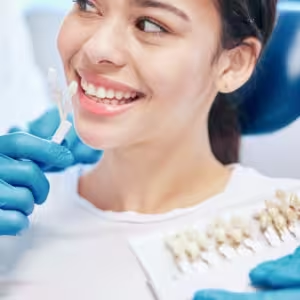
As dental technology advances, the field of restorative dentistry is continually evolving. Dental crowns, a common solution for damaged or decayed teeth, have undergone significant changes over the years, and the future holds even more exciting possibilities. At Dental 32 in Ashburn, VA, Dr. Ninh is dedicated to keeping patients informed about the latest innovations in dental care. In this blog, we will explore emerging trends and technologies in dental crowns, discussing what patients can expect in the coming years.
Understanding Dental Crowns
Before diving into innovations, it’s important to understand what dental crowns are and their purpose. A dental crown is a tooth-shaped cap placed over a damaged tooth to restore its shape, size, strength, and appearance. Crowns can be made from various materials, including metal, porcelain, and ceramic, each offering different benefits. They are commonly used for:
- Protecting a weak tooth from breaking
- Restoring a broken tooth
- Covering a dental implant
- Supporting a tooth with a large filling
Innovations on the Horizon
1. Advanced Materials
The materials used in dental crowns are evolving, leading to stronger, more aesthetically pleasing options. Some exciting developments include:
Zirconia Crowns: Zirconia is a highly durable ceramic material that offers excellent strength and a natural appearance. Advances in zirconia technology are making it possible to create crowns that are not only robust but also thin, allowing for minimally invasive procedures.
Bioactive Materials: Researchers are exploring bioactive materials that can promote healing and regeneration within the mouth. These materials may release ions that help remineralize teeth and strengthen surrounding tissues, potentially making crowns more beneficial for overall dental health.
2. 3D Printing Technology
3D printing is revolutionizing many fields, including dentistry. In the realm of dental crowns, this technology offers several advantages:
Customizability: 3D printing allows for highly customized crowns tailored to each patient’s unique dental anatomy. This precision enhances fit and comfort, reducing the likelihood of adjustments post-placement.
Speed: Traditional crown fabrication can take days or even weeks. With 3D printing, crowns can be produced in a matter of hours, significantly shortening the time from diagnosis to placement.
Cost-Effectiveness: As 3D printing technology becomes more widespread, it may help reduce costs associated with crown production, making restorative care more accessible for patients.
3. CAD/CAM Technology
Computer-Aided Design and Computer-Aided Manufacturing (CAD/CAM) technology is another innovation transforming the dental industry. This technology allows dentists to create and place crowns in a single visit. Here’s how it works:
Digital Impressions: Instead of traditional molds, which can be uncomfortable, CAD/CAM systems use digital scanners to create precise 3D images of the teeth. This enhances accuracy and patient comfort.
In-Office Milling: Once the digital design is created, the crown can be milled on-site, eliminating the need for temporary crowns and multiple visits.
This technology not only streamlines the process but also enhances the overall patient experience by reducing wait times.
4. Improved Adhesive Technologies
The bonding process for dental crowns is critical for their success. Innovations in adhesive technologies are making it easier to achieve strong, lasting bonds between crowns and natural teeth. Some key developments include:
Dual-Cure Adhesives: These adhesives can harden both chemically and with light activation, providing greater versatility and reliability in bonding crowns.
Self-Adhesive Resin Cements: These products simplify the bonding process by eliminating the need for additional primers or adhesives, making crown placement more straightforward and efficient.
5. Artificial Intelligence (AI) in Treatment Planning
AI is making its way into dental care, including the planning and placement of crowns. Here’s how it can benefit patients:
Predictive Analytics: AI can analyze a patient’s dental history and current condition to predict potential issues, helping dentists recommend crowns preemptively before significant damage occurs.
Enhanced Imaging: AI-enhanced imaging can improve the accuracy of diagnoses and treatment plans, leading to better outcomes for crown placements.
6. Personalized Treatment Plans
As dental technology advances, the trend toward personalized medicine continues to grow. In the context of dental crowns, this means:
Tailored Solutions: Crowns will increasingly be designed based on individual patient needs, considering factors such as tooth color, shape, and functional requirements.
Holistic Approach: Future innovations will focus not just on the crown itself but also on the overall oral health of the patient. This may involve integrating crowns into broader treatment plans that address gum health, bite alignment, and more.
The Patient Experience
As these innovations come to fruition, the patient experience will improve significantly. Here’s what patients can expect:
Less Chair Time: With advances like 3D printing and CAD/CAM technology, patients may spend less time in the dental chair, making visits more convenient.
Enhanced Comfort: New materials and techniques will lead to a more comfortable experience during both the placement of crowns and their long-term wear.
Greater Satisfaction: With improved aesthetics and functionality, patients can expect crowns that look natural and perform well, contributing to their overall satisfaction with dental care.
Conclusion
The future of dental crowns is bright, with numerous innovations on the horizon that promise to enhance the effectiveness and comfort of restorative dental care. At Dental 32 in Ashburn, VA, Dr. Ninh is committed to staying at the forefront of these advancements to provide patients with the best possible care.
If you have questions about dental crowns or are considering restorative options, don’t hesitate to reach out. Our team is here to guide you through the latest innovations and help you achieve a healthy, beautiful smile. Contact Dental 32 today to schedule a consultation!
FAQs
Non-covered benefits may not be deemed medically necessary by insurance providers but can still be essential for maintaining dental health.
If a procedure isn’t covered by insurance, it’s essential to discuss alternative payment options with your dentist and budget for the expense accordingly.
Regular dental check-ups are critical for preventive care, regardless of insurance coverage. Skipping them can lead to more significant dental issues in the future
Budgeting for dental expenses ensures that you can cover the costs of non-covered benefits and access necessary treatments when needed.
